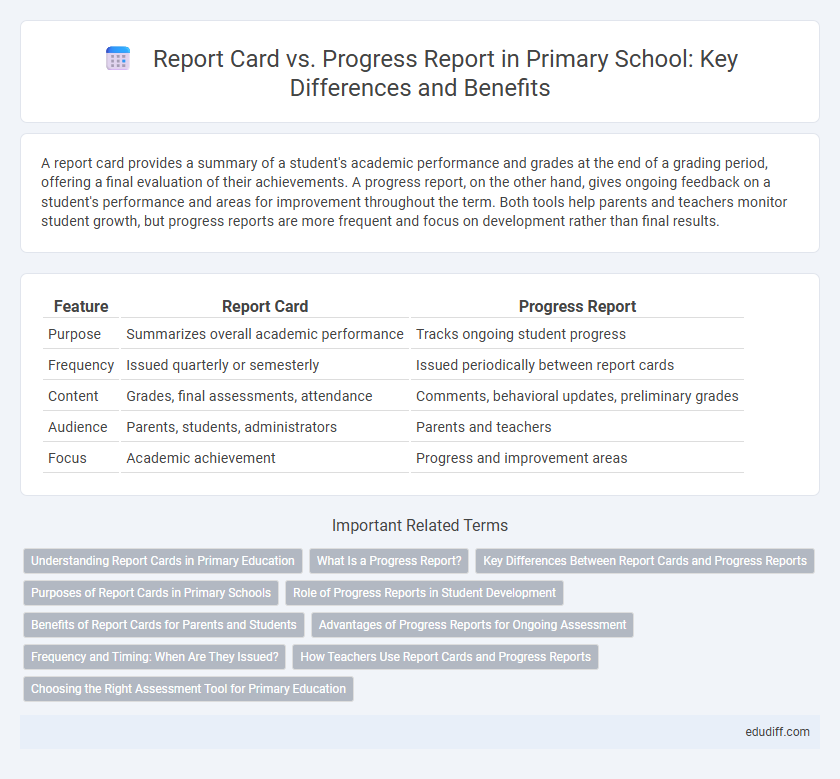A report card provides a summary of a student's academic performance and grades at the end of a grading period, offering a final evaluation of their achievements. A progress report, on the other hand, gives ongoing feedback on a student's performance and areas for improvement throughout the term. Both tools help parents and teachers monitor student growth, but progress reports are more frequent and focus on development rather than final results.
Table of Comparison
| Feature | Report Card | Progress Report |
|---|---|---|
| Purpose | Summarizes overall academic performance | Tracks ongoing student progress |
| Frequency | Issued quarterly or semesterly | Issued periodically between report cards |
| Content | Grades, final assessments, attendance | Comments, behavioral updates, preliminary grades |
| Audience | Parents, students, administrators | Parents and teachers |
| Focus | Academic achievement | Progress and improvement areas |
Understanding Report Cards in Primary Education
Report cards in primary education provide a comprehensive overview of a student's academic performance, assessing core subjects such as mathematics, reading, and science, along with behavioral and social development. Unlike progress reports, which offer frequent updates on a student's ongoing learning and areas needing improvement, report cards summarize overall achievement at the end of grading periods. Understanding the detailed feedback on report cards helps parents and teachers support targeted interventions and track long-term educational growth in young learners.
What Is a Progress Report?
A progress report in primary education provides real-time updates on a student's academic performance and behavior, highlighting strengths and areas needing improvement. It offers specific, actionable feedback for teachers, parents, and students to monitor ongoing development throughout the term. Progress reports differ from report cards by focusing on continuous assessment rather than final grades or overall achievement.
Key Differences Between Report Cards and Progress Reports
Report cards provide a comprehensive summary of a student's academic performance, often issued at the end of a grading period, highlighting grades and overall achievement across subjects. Progress reports offer interim updates on a student's current understanding, behavior, and areas needing improvement, typically shared mid-term to guide timely interventions. The key difference lies in the timing and purpose: report cards evaluate cumulative performance, while progress reports monitor ongoing progress.
Purposes of Report Cards in Primary Schools
Report cards in primary schools serve to communicate a student's academic performance and overall development to parents and guardians, offering a comprehensive evaluation of achievements across subjects. They provide a formal summary of grades, learning progress, and behavioral observations, enabling educators to highlight strengths and areas needing improvement. This tool aids in setting educational goals and fostering collaboration between teachers and families to support the student's growth.
Role of Progress Reports in Student Development
Progress reports play a crucial role in student development by providing ongoing, formative feedback that helps identify strengths and areas needing improvement. Unlike report cards that summarize overall achievement at the end of a grading period, progress reports offer timely insights allowing for early intervention and personalized support. This continuous assessment enhances student engagement, goal setting, and academic growth throughout the term.
Benefits of Report Cards for Parents and Students
Report cards provide parents and students with a clear, comprehensive overview of academic performance, enabling targeted support and motivation. They offer a structured summary of strengths and areas for improvement, facilitating goal setting and timely interventions. Consistent feedback through report cards enhances communication between teachers and families, promoting student accountability and progress tracking.
Advantages of Progress Reports for Ongoing Assessment
Progress reports offer continuous insights into a student's development, enabling early identification of learning gaps and tailored interventions. Regular updates foster transparent communication between teachers and parents, promoting collaborative support for academic growth. These ongoing assessments encourage student self-reflection and motivation by highlighting strengths and areas needing improvement throughout the grading period.
Frequency and Timing: When Are They Issued?
Report cards in primary education are typically issued at the end of each grading period, often quarterly or trimesterly, providing a comprehensive summary of student performance. Progress reports are distributed more frequently, usually midway through a grading period, to offer timely feedback on a student's academic progress and areas needing improvement. The distinct timing of these documents ensures parents receive both periodic evaluations and ongoing updates throughout the school year.
How Teachers Use Report Cards and Progress Reports
Teachers use report cards to summarize a student's academic performance, behavior, and attendance at the end of a grading period, providing a comprehensive evaluation for parents and school administrators. Progress reports, in contrast, serve as interim updates that highlight a student's current strengths and areas needing improvement, allowing for timely interventions and adjustments in teaching strategies. Both tools help educators communicate student progress, guide instructional planning, and support personalized learning in primary education.
Choosing the Right Assessment Tool for Primary Education
Report cards provide a comprehensive summary of a primary student's overall academic performance at the end of a grading period, while progress reports offer interim updates on learning progress and areas needing improvement. Teachers should select report cards to communicate final achievement levels to parents and progress reports to monitor ongoing development and tailor instruction in primary education. Choosing the appropriate assessment tool depends on the need for either summative evaluation or formative feedback in the primary classroom.
Report Card vs Progress Report Infographic

 edudiff.com
edudiff.com